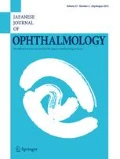Abstract
Purpose
To determine whether the International Revised Diagnostic Criteria for Vogt-Koyanagi-Harada (VKH) disease is applicable to Japanese patients at the early stage of VKH disease.
Methods
The medical records of 49 patients with VKH disease were studied. The patients had been examined at the Akita University School of Medicine Hospital between 1989 and 2001, and their mean age was 47.6 years with a range of 15 to 69 years. In our study, the patients were divided into two groups; an Early Group, which consisted of those who were examined within 1 month of the onset of signs or symptoms, and a Late Group, which consisted of those who were examined more than 1 month after the onset of signs or symptoms. The initial diagnosis was based on findings by ophthalmoscopy, fluorescein angiography, pleocytosis of cerebrospinal fluid, and genotyping of human leukocyte antigen (HLA). The final diagnosis was based on the presence of these findings in addition to skin and internal ear manifestations of VKH disease.
Results
In our retrospective study, 41 of the 49 patients were placed in the Early Group, and 8 were placed in the Late Group. When classified by the Revised Diagnostic Criteria, 39 of the 41 in the Early Group would have been diagnosed with incomplete VKH, and the other 2 patients would have been diagnosed as not having VKH disease. None of the patients would have been diagnosed as having complete VKH disease, even at 2 weeks after the onset of symptoms or signs. At the final examination, 35 patients would still have been classified as having incomplete VKH disease, and only 6 patients would have been classified as having complete VKH disease according to the Revised Diagnostic Criteria. In the Late Group, all of the patients would have been diagnosed as having incomplete VKH at 2 weeks after the onset of any signs or symptoms. At the final examination, two of eight patients would still have been diagnosed as having incomplete VKH, and the other six would have been diagnosed as having complete VKH. The skin manifestations always appeared later than the other alterations, with an average of 143.5 days from disease onset to detection.
Conclusions
Although the Revised Diagnostic Criteria are effective for making the final diagnosis of VKH disease, they are not an effective tool for diagnosis at the very early stage of VKH disease in Japanese patients.
Similar content being viewed by others
Author information
Authors and Affiliations
Corresponding author
About this article
Cite this article
Yamaki, K., Hara, K. & Sakuragi, S. Application of revised diagnostic criteria for Vogt-Koyanagi-Harada disease in Japanese patients. Jpn J Ophthalmol 49, 143–148 (2005). https://doi.org/10.1007/s10384-004-0165-9
Received:
Accepted:
Published:
Issue Date:
DOI: https://doi.org/10.1007/s10384-004-0165-9




